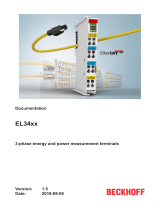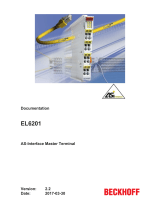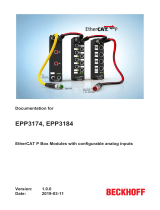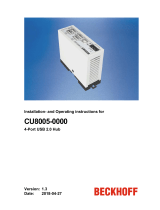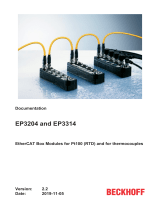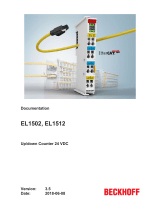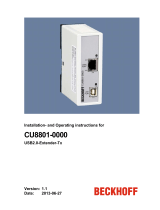Page is loading ...

Documentation
EK9500
Ethernet/IP - Bus Coupler for EtherCAT Terminals
1.0.0
2019-09-17
Version:
Date:


Table of contents
EK9500 3Version: 1.0.0
Table of contents
1 Foreword ....................................................................................................................................................5
1.1 Notes on the documentation..............................................................................................................5
1.2 Safety instructions .............................................................................................................................6
1.3 Documentation issue status ..............................................................................................................7
1.4 Version identification of EtherCAT devices .......................................................................................7
1.4.1 Beckhoff Identification Code (BIC)................................................................................... 11
2 Product overview.....................................................................................................................................13
2.1 EKxxxx - System overview ..............................................................................................................13
2.2 EK9500 - Introduction......................................................................................................................14
2.3 Technical data .................................................................................................................................15
3 Mounting and wiring................................................................................................................................16
3.1 Mounting..........................................................................................................................................16
3.1.1 Instructions for ESD protection ........................................................................................ 16
3.1.2 Dimensions ...................................................................................................................... 17
3.1.3 Installation on mounting rails – Bus Coupler ................................................................... 17
3.2 Wiring...............................................................................................................................................19
3.2.1 Power supply ................................................................................................................... 19
3.2.2 Ethernet ........................................................................................................................... 21
3.3 UL notice .........................................................................................................................................25
3.4 ATEX - Special conditions (standard temperature range) ...............................................................26
3.5 ATEX Documentation ......................................................................................................................27
4 Parameterization and commissioning...................................................................................................28
4.1 Further interfaces ............................................................................................................................28
4.2 IP address .......................................................................................................................................28
4.3 DIP switch........................................................................................................................................28
5 Configuration ...........................................................................................................................................30
5.1 Configuration via the HTML pages of the Bus Coupler ...................................................................30
5.2 EtherCAT configuration ...................................................................................................................31
5.3 EtherNet/IP Configuration................................................................................................................34
5.4 EtherNet/IP Mapping .......................................................................................................................38
5.5 EK9500 - EtherCAT configurations .................................................................................................38
6 Error handling and diagnosis.................................................................................................................42
6.1 LED indicators .................................................................................................................................42
7 Appendix ..................................................................................................................................................45
7.1 Update Bus Coupler image .............................................................................................................45
7.2 Setting up the EK9500 in RS Logix Studio 5000 via EDS File ........................................................46
7.3 Setting up an EK9500 as a Generic Device in RS Logix Studio 5000.............................................48
7.4 Using the CtrlStatus DWORD..........................................................................................................50
7.5 Supported CIP objects.....................................................................................................................50
7.6 FAQ .................................................................................................................................................52
7.7 List of Abbreviations ........................................................................................................................52
7.8 Support and Service ........................................................................................................................54

Table of contents
EK95004 Version: 1.0.0

Foreword
EK9500 5Version: 1.0.0
1 Foreword
1.1 Notes on the documentation
Intended audience
This description is only intended for the use of trained specialists in control and automation engineering who
are familiar with the applicable national standards.
It is essential that the documentation and the following notes and explanations are followed when installing
and commissioning these components.
It is the duty of the technical personnel to use the documentation published at the respective time of each
installation and commissioning.
The responsible staff must ensure that the application or use of the products described satisfy all the
requirements for safety, including all the relevant laws, regulations, guidelines and standards.
Disclaimer
The documentation has been prepared with care. The products described are, however, constantly under
development.
We reserve the right to revise and change the documentation at any time and without prior announcement.
No claims for the modification of products that have already been supplied may be made on the basis of the
data, diagrams and descriptions in this documentation.
Trademarks
Beckhoff
®
, TwinCAT
®
, EtherCAT
®
, EtherCATG
®
, EtherCATG10
®
, EtherCATP
®
, SafetyoverEtherCAT
®
,
TwinSAFE
®
, XFC
®
, XTS
®
and XPlanar
®
are registered trademarks of and licensed by Beckhoff Automation
GmbH. Other designations used in this publication may be trademarks whose use by third parties for their
own purposes could violate the rights of the owners.
Patent Pending
The EtherCAT Technology is covered, including but not limited to the following patent applications and
patents: EP1590927, EP1789857, EP1456722, EP2137893, DE102015105702 with corresponding
applications or registrations in various other countries.
EtherCAT
®
is registered trademark and patented technology, licensed by Beckhoff Automation GmbH,
Germany.
Copyright
© Beckhoff Automation GmbH & Co. KG, Germany.
The reproduction, distribution and utilization of this document as well as the communication of its contents to
others without express authorization are prohibited.
Offenders will be held liable for the payment of damages. All rights reserved in the event of the grant of a
patent, utility model or design.

Foreword
EK95006 Version: 1.0.0
1.2 Safety instructions
Safety regulations
Please note the following safety instructions and explanations!
Product-specific safety instructions can be found on following pages or in the areas mounting, wiring,
commissioning etc.
Exclusion of liability
All the components are supplied in particular hardware and software configurations appropriate for the
application. Modifications to hardware or software configurations other than those described in the
documentation are not permitted, and nullify the liability of Beckhoff Automation GmbH & Co. KG.
Personnel qualification
This description is only intended for trained specialists in control, automation and drive engineering who are
familiar with the applicable national standards.
Description of instructions
In this documentation the following instructions are used.
These instructions must be read carefully and followed without fail!
DANGER
Serious risk of injury!
Failure to follow this safety instruction directly endangers the life and health of persons.
WARNING
Risk of injury!
Failure to follow this safety instruction endangers the life and health of persons.
CAUTION
Personal injuries!
Failure to follow this safety instruction can lead to injuries to persons.
NOTE
Damage to environment/equipment or data loss
Failure to follow this instruction can lead to environmental damage, equipment damage or data loss.
Tip or pointer
This symbol indicates information that contributes to better understanding.

Foreword
EK9500 7Version: 1.0.0
1.3 Documentation issue status
Version Comment
1.0.0 • 1
st
Public issue EK9500
• Addenda
0.0.4 • Corrections
0.0.3 • Addenda CIP objects
0.0.2 • Addenda, corrections
0.0.1 • Preliminary version
1.4 Version identification of EtherCAT devices
Designation
A Beckhoff EtherCAT device has a 14-digit designation, made up of
• family key
• type
• version
• revision
Example Family Type Version Revision
EL3314-0000-0016 EL terminal
(12 mm, non-
pluggable connection
level)
3314 (4-channel thermocouple
terminal)
0000 (basic type) 0016
ES3602-0010-0017 ES terminal
(12 mm, pluggable
connection level)
3602 (2-channel voltage
measurement)
0010 (high-
precision version)
0017
CU2008-0000-0000 CU device 2008 (8-port fast ethernet switch) 0000 (basic type) 0000
Notes
• The elements mentioned above result in the technical designation. EL3314-0000-0016 is used in the
example below.
• EL3314-0000 is the order identifier, in the case of “-0000” usually abbreviated to EL3314. “-0016” is the
EtherCAT revision.
• The order identifier is made up of
- family key (EL, EP, CU, ES, KL, CX, etc.)
- type (3314)
- version (-0000)
• The revision -0016 shows the technical progress, such as the extension of features with regard to the
EtherCAT communication, and is managed by Beckhoff.
In principle, a device with a higher revision can replace a device with a lower revision, unless specified
otherwise, e.g. in the documentation.
Associated and synonymous with each revision there is usually a description (ESI, EtherCAT Slave
Information) in the form of an XML file, which is available for download from the Beckhoff web site.
From 2014/01 the revision is shown on the outside of the IP20 terminals, see Fig. “EL5021 EL terminal,
standard IP20 IO device with batch number and revision ID (since 2014/01)”.
• The type, version and revision are read as decimal numbers, even if they are technically saved in
hexadecimal.
Identification number
Beckhoff EtherCAT devices from the different lines have different kinds of identification numbers:

Foreword
EK95008 Version: 1.0.0
Production lot/batch number/serial number/date code/D number
The serial number for Beckhoff IO devices is usually the 8-digit number printed on the device or on a sticker.
The serial number indicates the configuration in delivery state and therefore refers to a whole production
batch, without distinguishing the individual modules of a batch.
Structure of the serial number: KKYYFFHH
KK - week of production (CW, calendar week)
YY - year of production
FF - firmware version
HH - hardware version
Example with
Ser. no.: 12063A02: 12 - production week 12 06 - production year 2006 3A - firmware version 3A 02 -
hardware version 02
Exceptions can occur in the IP67 area, where the following syntax can be used (see respective device
documentation):
Syntax: D ww yy x y z u
D - prefix designation
ww - calendar week
yy - year
x - firmware version of the bus PCB
y - hardware version of the bus PCB
z - firmware version of the I/O PCB
u - hardware version of the I/O PCB
Example: D.22081501 calendar week 22 of the year 2008 firmware version of bus PCB: 1 hardware version
of bus PCB: 5 firmware version of I/O PCB: 0 (no firmware necessary for this PCB) hardware version of I/O
PCB: 1
Unique serial number/ID, ID number
In addition, in some series each individual module has its own unique serial number.
See also the further documentation in the area
• IP67: EtherCAT Box
• Safety: TwinSafe
• Terminals with factory calibration certificate and other measuring terminals
Examples of markings
Fig.1: EL5021 EL terminal, standard IP20 IO device with serial/ batch number and revision ID (since
2014/01)

Foreword
EK9500 9Version: 1.0.0
Fig.2: EK1100 EtherCAT coupler, standard IP20 IO device with serial/ batch number
Fig.3: CU2016 switch with serial/ batch number
Fig.4: EL3202-0020 with serial/ batch number 26131006 and unique ID-number 204418

Foreword
EK950010 Version: 1.0.0
Fig.5: EP1258-00001 IP67 EtherCAT Box with batch number/ date code 22090101 and unique serial
number 158102
Fig.6: EP1908-0002 IP67 EtherCAT Safety Box with batch number/ date code 071201FF and unique serial
number 00346070
Fig.7: EL2904 IP20 safety terminal with batch number/ date code 50110302 and unique serial number
00331701
Fig.8: ELM3604-0002 terminal with unique ID number (QR code) 100001051 and serial/ batch number
44160201

Foreword
EK9500 11Version: 1.0.0
1.4.1 Beckhoff Identification Code (BIC)
The Beckhoff Identification Code (BIC) is increasingly being applied to Beckhoff products to uniquely identify
the product. The BIC is represented as a Data Matrix Code (DMC, code scheme ECC200), the content is
based on the ANSI standard MH10.8.2-2016.
Fig.9: BIC as data matrix code (DMC, code scheme ECC200)
The BIC will be introduced step by step across all product groups.
Depending on the product, it can be found in the following places:
• on the packaging unit
• directly on the product (if space suffices)
• on the packaging unit and the product
The BIC is machine-readable and contains information that can also be used by the customer for handling
and product management.
Each piece of information can be uniquely identified using the so-called data identifier (ANSI
MH10.8.2-2016). The data identifier is followed by a character string. Both together have a maximum length
according to the table below. If the information is shorter, it shall be replaced by spaces. The data under
positions 1-4 are always available.
The following information is contained:

Foreword
EK950012 Version: 1.0.0
Item
no.
Type of informa-
tion
Explanation Data identifier Number of
digits incl.
data identi-
fier
Example
1 Beckhoff order
number
Beckhoff order number 1P 8 1P072222
2 Beckhoff
Traceability
Number (BTN)
Unique serial number,
see note below
S 12 SBTNk4p562d7
3 Article description Beckhoff article
description, e.g. EL1008
1K 32 1KEL1809
4 Quantity Quantity in packaging
unit, e.g. 1, 10, etc.
Q 6 Q1
5 Batch number Optional: Year and week of
production
2P 14 2P40150318001
6
6 ID/serial number Optional: Present-day serial
number system, e.g. with
safety products
51S 12 51S678294104
7 Variant number Optional: Product variant
number on the basis of
standard products
30P 32 30PF971 ,
2*K183
...
Further types of information and data identifiers are used by Beckhoff and serve internal processes.
Structure of the BIC
Example of composite information from items 1 - 4 and 6. The data identifiers are marked in red for better
display:
BTN
An important component of the BIC is the Beckhoff Traceability Number (BTN, item no. 2). The BTN is a
unique serial number consisting of eight characters that will replace all other serial number systems at
Beckhoff in the long term (e.g. batch designations on IO components, previous serial number range for
safety products, etc.). The BTN will also be introduced step by step, so it may happen that the BTN is not yet
coded in the BIC
Notice
This information has been carefully prepared. However, the procedure described is constantly being further
developed. We reserve the right to revise and change procedures and documentation at any time and
without prior notice. No claims for changes can be made from the information, illustrations and descriptions
in this information.

Product overview
EK9500 13Version: 1.0.0
2 Product overview
2.1 EKxxxx - System overview
Fig.10: EtherCAT Terminals at an EKxxxx series Bus Coupler
The Bus Couplers from the EKxxxx series allow EtherCAT Terminals to be operated on conventional fieldbus
systems. The ultra-fast, high-performance EtherCAT Terminals with their large range of signal types are thus
also available for other fieldbus and Industrial Ethernet systems.
The EKxxxx Bus Couplers are fieldbus slaves and contain an EtherCAT master for the EtherCAT terminals.
They convert the telegrams from the higher-level fieldbus systems into the E-bus signal representation. A
station consists of an EKxxxx and a number of EtherCAT Terminals.
The EKxxxx is integrated in exactly the same way as the Bus Couplers from the BKxxxx series via the
corresponding fieldbus system configuration tools and the associated configuration files, such as GSD, ESD
or GSDML.
EtherCAT makes a very flexible topology configuration possible. Thanks to the Ethernet physics, long
distances can also be bridged without the bus speed being affected. When changing to the field level –
without a control cabinet – the EtherCAT Box modules (EPxxxx) in protection class IP65 can also be
connected to the EK9xxx.
Bus Couplers for various fieldbus systems
The variants from the EKxxxx series differ from one another by the interface for the higher-level fieldbus
system.
An overview of the various Beckhoff Bus Couplers covering the most important fieldbus systems can be
found on the Beckhoff Website.
Embedded PCs with fieldbus interface and decentralized control
The TwinCAT-programmable variant is the CX80xx Embedded PC series.
The variants from the CX80xx series differ from one another by the interface for the higher-level fieldbus
system and the possibility to program it.
An overview of the various Beckhoff Embedded PCs covering the most important fieldbus systems can be
found on the Beckhoff Website.

Product overview
EK950014 Version: 1.0.0
2.2 EK9500 - Introduction
Fig.11: EK9500
The EK9500 Bus Coupler connects Ethernet/IP networks with the EtherCAT Terminals (ELxxxx) and
EtherCAT Box modules (EPxxxx) and converts the telegrams from Ethernet/IP to E-bus signal
representation.
One station consists of an EK9500 and EtherCAT Terminals. RJ45 is used for the Ethernet/IP connection. In
EtherCAT, the Ethernet/IP coupler has at its disposal a lower-level, powerful and ultra-fast I/O system with a
large selection of terminals. The coupler supports the EtherNet/IP protocol and therefore fits seamlessly into
Ethernet/IP networks.
Configuration
The EK9500 is configured based on HTML pages provided by the Bus Coupler or via the EtherNet/IP
interface.

Product overview
EK9500 15Version: 1.0.0
2.3 Technical data
Technical data EK9500
Protocol EtherNet/IP
Interfaces 2 x Ethernet 100 Mbit/s, 1 x USB device (behind the front flap)
Bus interface 2 x RJ 45 (switched)
I/O connection E-Bus (EtherCAT terminals)
Web-based Management yes
I/O terminals E-bus (EL, ES, EP), standard digital signals, standard analog
signals
No gateway EC terminals, no EC terminals with XFC or DC
function, no general EtherCAT devices
Number of EC terminals max. 255
Max. size of process data 496 bytes input and 496 bytes output data
1)
Supply voltage 24V
DC
(-15%/+20%)
Power supply I/O terminals 2A
Max. power loss 3 W
Power contacts 24V
DC
max./10A max.
Electrical isolation 500V (power contact/supply voltage/Ethernet)
Dimensions (W x H x L) 64mm x 100mm x 80mm
Operating/storage temperature 0…+55°C/-25…+85°C
Relative humidity 95 % no condensation
Vibration/shock resistance conforms to EN 60068-2-6 / EN 60068-2-27
EMC immunity/emission conforms to EN 61000-6-2 / EN 61000-6-4
Protect. class / installation pos. IP20/any
Approvals
CE, cULus [}25], ATEX [}26]
1) The acyclic communication via GetAttributeSingle/SetAttributeSingle can be used to read and write >
1000bytes.
System data Ethernet/IP (EK9500)
Number of I/O modules depending on controller
Number of I/O points depending on controller
Transmission medium 4 x 2 twisted pair copper cable category 5 (100 Mbit/s)
Cable length 100m
Data transfer rate 100 Mbit/s
Topology Star-form cabling, line topology

Mounting and wiring
EK950016 Version: 1.0.0
3 Mounting and wiring
3.1 Mounting
3.1.1 Instructions for ESD protection
NOTE
Destruction of the devices by electrostatic discharge possible!
The devices contain components at risk from electrostatic discharge caused by improper handling.
• Please ensure you are electrostatically discharged and avoid touching the contacts of the device directly.
• Avoid contact with highly insulating materials (synthetic fibers, plastic film etc.).
• Surroundings (working place, packaging and personnel) should by grounded probably, when handling
with the devices.
• Each assembly must be terminated at the right hand end with an EL9011 or EL9012 bus end cap, to en-
sure the protection class and ESD protection.
Fig.12: Spring contacts of the Beckhoff I/O components

Mounting and wiring
EK9500 17Version: 1.0.0
3.1.2 Dimensions
The following illustrations show the dimensions of the Bus Couplers.
Drawings in DWF and STEP format can be found in the Download section of the Beckhoff website.
Fig.13: EK9xxx – dimensions taking the EK9300 as an example
3.1.3 Installation on mounting rails – Bus Coupler
Snapping onto the mounting rail
The Bus Coupler can simply be snapped onto the mounting rail. To this end position the block on the
mounting rail and push it slightly until it engages on the right-hand side. This is indicated by a distinct click.
Use a screwdriver to push up the lock on the left-hand side, thereby turning it and causing it to engage
audibly.
Fig.14: EK9300 - Snapping onto the mounting rail
NOTE
Avoid damage!
Do not force the module or apply excessive pressure!

Mounting and wiring
EK950018 Version: 1.0.0
Installation positions
The installation position of the Bus Coupler is arbitrary.
NOTE
Installation position of EtherCAT terminals
Observe the installation position of the EtherCAT terminals used – not all of them have an arbitrary installa-
tion position. Pay attention to the respective EtherCAT infrastructure components and installation instruc-
tions.
Fig.15: Recommended distances for standard installation position
NOTE
Comply with the permitted installation position and minimum distances!
We recommend the installation in the horizontal position for optimum ventilation. Furthermore, it is not nec-
essary with this installation position to check whether there are terminals present that may only be installed
horizontally.
Other installation positions are allowed, but not recommended.

Mounting and wiring
EK9500 19Version: 1.0.0
Fig.16: Other installation positions
3.2 Wiring
3.2.1 Power supply
The power supply unit is equipped with an I/O interface, which permits connection of the Beckhoff Bus
Terminals. The power is supplied via the upper spring-loaded terminals with the designations "24V and
"0V".
The supply voltage supplies the EK system and, via the terminal bus, the Bus Terminals with a voltage of 24
V
DC
(-15%/+20%). The dielectric strength of the power supply is 500 V. Since the terminal bus (E-bus) only
transfers data, a separate power supply is required for the Bus Terminals. This is provided by means of the
power contacts, which are not connected to the power supply.

Mounting and wiring
EK950020 Version: 1.0.0
Fig.17: Bus Coupler EK9xxx power supply
Requirements for the 24 V power supply
In order to guarantee the operation of the Bus Coupler and the terminal segment in all cases, the power
supply unit must supply 2.0 A at 24 V.
LED
If the power supply unit is connected correctly and the power supply is switched on, the two upper LEDs in
the terminal prism are green. The left LED (Us) indicates the CPU supply. The right LED (Up) indicates the
terminal supply. The other LEDs indicate the Terminal Bus status. A detailed description of the LEDs can be
found in section "LED troubleshooting".
PE power contacts
NOTE
Power contact “PE”
The "PE" power contact must not be used for other potentials.
/
